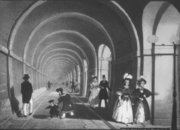Tunnel
|
|
A tunnel is an underground passage. When designed for use by traffic, it may be called an underpass.
It may be for pedestrians and/or cyclists, for general road traffic, for motor vehicles only, for rail traffic, or for a canal. Some tunnels are constructed purely for carrying water (for consumption, for hydroelectric purposes or as sewers), while others carry other services such as telecommunications cables. There are even tunnels designed as wildlife crossings for European badgers and other endangered species.
Tunnels are dug in various types of materials, from soft clays to hard rocks. Depending on the type of soil, a method of excavation is chosen. When digging soft clays, the New Austrian Tunneling method or NATM might be applied. When digging in weak rocks a tunnel boring machine or TBM is often used. In hard rocks, blasting may be deemed most suitable, as in the Norwegian tunneling method.
Various combinations of these methods and many others are also possible. The central part of a metro network is usually built in tunnels. To allow non-level crossings, some lines are in deeper tunnels than others. At metro stations there are often also pedestrian tunnels to walk from one platform to another.
Ground-level railway stations often have one or more pedestrian tunnels under the railway to enable passengers to reach the platforms without having to walk across the tracks.
In the UK a pedestrian tunnel or other underpass beneath a road is called a "subway". This term was also used in the past in the US, but is now used to refer to underground mass transit systems (which are generally called metros outside the US).
Laerdalstunnel_cave.jpg
The Lærdal Tunnel in Norway stretching from Lærdal to Aurland is the world's longest road tunnel at 24.5 km, with the St. Gotthard Tunnel that opened in Switzerland on September 5, 1980 as the world's longest highway tunnel at 16.32 km (10.14 miles) stretching from Göschenen to Airolo. By contrast, rail tunnels like the Seikan Tunnel in Japan and the Channel tunnel between England and France both exceed 50 km (30 miles). A new St. Gotthard Rail Tunnel with a length of 57 km (36 mi) is currently under construction.
| Contents |
Types of tunnels
- Soft ground
- Hard rock
- Underwater
- Immersed tube such as Sydney Harbour Tunnel
Construction
Tunnel_Boring_Machine_(Yucca_Mt).jpg
Cut-and-cover is a simple method of construction for shallow tunnels where a trench is excavated and roofed over. Strong supporting beams are necessary to avoid the danger of the tunnel collapsing.
Shallow tunnels are of the cut-and-cover type (if under water of the immersed-tube type), deep tunnels are excavated, often using a tunnelling shield. For intermediate levels, both methods are possible.
Tunnel boring machines can be used to automate the entire tunneling process. There are a variety of Tunnel Boring Machines (TBMs) that can operate in a variety of conditions. One type of TBM called an earth-pressure balance machine can be used deep below the water table. This type of TBM pressurizes the cutter head with either fluid or air in order to balance the water pressure. As a result operaters of the TBM must go through decompression chambers, much like divers.
Choice of tunnels vs. bridges
For water crossings, a tunnel is generally more costly to construct than a bridge. However, navigational considerations may limit the use of high bridges or drawbridge spans when intersecting with shipping channels at some locations, necessitating use of a tunnel. Examples of such tunnels include the Holland Tunnel and Lincoln Tunnel between New Jersey and Manhattan Island in New York City, and the Elizabeth River tunnels between Norfolk and Portsmouth, Virginia.
Examples of tunnels
- The Channel Tunnel between France and England under the English Channel is the second longest tunnel in the world, with a total length of 50 km (31 miles), out of which 39 km (24 miles) are under the sea;
- The Lincoln Tunnel between New Jersey and New York is one of the busiest vehicular tunnels in the world.
- The Sapperton Tunnel in the Thames & Severn Canal in England, dug through hills, which opened in 1789, was 3.5 km long and allowed ship transport of coal. Above it runs the Sapperton Long Tunnel which carries the "Golden Valley" railway line between Swindon and Gloucester.
- The Seikan Tunnel in Japan is the longest tunnel in the world at 53.9 km (33.4 miles).
- Box Tunnel in England, which opened in 1841, one of the oldest railway tunnels in the world at the time of construction. It is dug and has a length of 2900 m.
- The Thames Tunnel built by Marc Isambard Brunel and his son Isambard Kingdom Brunel which opened in 1843 - the first underwater tunnel and the first to use a tunnelling shield.
- The Atlantic Avenue Tunnel, Brooklyn, New York is the world's oldest underground railway tunnel in a street, built in 1844 by the cut-and-cover method for the Long Island Rail Road. It is 800 m long.
- The Lærdal Tunnel in Norway is the world's longest road tunnel at a length of 24.5 km.
- The North Cape Tunnel in northern Norway, connecting the island of Magerøya with the mainland, was the world's longest undersea road tunnel when opened in 1999, at a length of about 7 km. It reaches a depth of 212 m below sea level and was constructed from 1995 to 1999.
See also
- List of tunnels
- Wind tunnel
- Underground city
- Tunnel (nightclub)
- Urban exploration
- Roof and tunnel hacking
- New York City Water Tunnel No. 3
External links
- Directory of the world's longest tunnels (http://home.no.net/lotsberg/index.html) by categoryda:Tunnel

